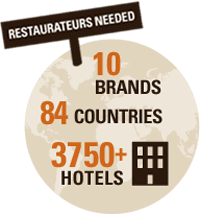 Wish you were one of those hotshot restaurateurs who cut deals with big hotel chains to expand their concept far and wide? Good news. Hilton Worldwide, 3,800 hotels strong, has set up a dedicated website through which operators can pitch their brands to the company.
Wish you were one of those hotshot restaurateurs who cut deals with big hotel chains to expand their concept far and wide? Good news. Hilton Worldwide, 3,800 hotels strong, has set up a dedicated website through which operators can pitch their brands to the company.
Hilton isn’t just looking for a few good concepts, either. It needs a lot of good concepts. The company says its goal is to put 500 new restaurants in place globally over the next three years.
Hilton oversees 10 hotel brands whose price points range from modest (Hampton Hotels) through mid-priced (DoubleTree by Hilton) on up to the make-sure-to-pack-the-platinum-card level (Waldorf Astoria Hotels & Resorts). It needs many different kinds of concepts to match up with this broad portfolio of properties.
Finding them is a tall order for any hotel company, even one of Hilton’s size and expertise. That’s why the company is making it easy for your concept to get noticed. It has set up a dedicated website, www.hiltonrestaurantconcepts.com, “to help partner with approved restaurateurs in bringing their concepts to our hotels.”
More than 900 hotel owners visited the internal version of this website before it went public. Some deals have already been made via this initial effort, and Hilton is expecting plenty more once additional restaurant concepts have been added to the roster. Note that any deals that result will be between individual hotel owners and the restaurant concept owner, not the Hilton Worldwide umbrella organization.
“Our goal is to provide our hotels with great concepts that are unique to their regions and offer menu options that will appeal to their repeat customer base,” says Beth Scott, v.p. of food and beverage concepts for Hilton Worldwide. “It’s also a great opportunity for restaurateurs interesting in growing their brand.”
The process works this way. First, operators upload details about their concept—menus, design elements, pricing structure, photos and any other information that might appeal to a hotel owner shopping for a new restaurant concept. Then Hilton reviews the material and posts it on the site. Once the material is up, it resides there for hotel owners to review.
But you don’t necessarily have to wait until a hotel owner contacts you. The site also hosts a real-time feed detailing “Current Concept Requests.” “Restaurateurs can scroll through these listings and respond should there be a mutual interest,” Hilton points out. “Making contact is easy and communication is instant.”
What kind of restaurant concepts is Hilton looking for? The website poses these three questions to restaurateurs:
• Do you have a restaurant concept with proven success of over three years?
• Are you looking to expand in a non-traditional environment?
• Do you have experience operating your restaurant concept within a hotel environment?
These aren’t strict requirements, just general guidelines. For example, it’s likely that many of the kinds of operations Hilton hopes to attract have yet to open a unit in a hotel. Apply anyway.
Keep in mind what Scott told the Washington Post when announcing the project last year. “Local owners and local concepts make a whole lot of sense,” she said. “If we want to appeal to local clientele, we have to align ourselves with local restaurant operators that are already proven and know the market.”
HiltonRestaurantConcepts.com was an internal website back when Scott made these remarks. It’s external now, which tells us Hilton is casting a wider net. The company says 80-plus restaurant deals are in the works at present, and it wants to have 50 additional concepts available for its hotel owners to choose from by the end of 2012. Why not make yours one of them?
Hilton Worldwide is not responsible for any negotiations or deal structures.
Hilton Wants Restaurant Concepts Like Yours
Hilton Worldwide is looking for cool local restaurant concepts to put in their hotels. They’ve made it easy for you to tell them what you’ve got.
1 comment
Hide comments



